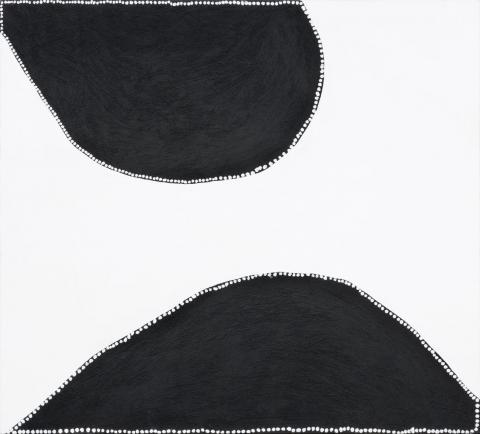THOOWOONGGOONARRIN, 2000
PADDY NYUNKUNY BEDFORD
natural earth pigments and synthetic binder on linen
122.0 x 135.0 cm
signed with initials verso: PB
bears inscription verso: Jirrawun Arts cat. PB 8 2000.91
Jirrawun Arts, Kununurra
Martin Browne Fine Art, Sydney
Private collection, Melbourne
My Mother's Country, My Father's Country: New Paintings by Paddy Bedford, Martin Browne Fine Art, Sydney, 12 September – 8 October 2000
Storer, R., Paddy Bedford, Museum of Contemporary Art, Sydney, 2006, pp. 43 (illus.), 149 (illus.)
In his eulogy to Paddy Bedford in September 2007, Sir William Deane recalled that he was a man of 'great dignity and spiritual strength - a much loved senior Elder and lawman who late in the story of his life discovered a rare artistic genius that resulted in him being recognised as one of the great painters of our continent’.1
Nyunkuny, commonly known by his nickname 'Kuwumji' and by his 'gardiya' name Paddy Bedford, was a Gija lawman of Jawalyi skin. Born at Bedford Downs Station in the East Kimberley in 1922, he was named by and after the infamous Paddy Quilty, owner of the station, with his surname coming from Bedford Downs, where he had worked as a stockman as a young man. When Aboriginal pastoral workers were finally awarded equal wages in 1969, Indigenous stockmen were unceremoniously expelled from cattle stations across the Kimberleys. During this time, Bedford lived between Nine Mile camp at Wyndham and Turkey Creek Mission settlement which was to become the home of the first great generation of East Kimberley artists in the early 1980s. According to Tony Oliver (who was instrumental in Bedford's career and the development of Jirrawun Aboriginal Art Corporation), Bedford was close friends with Paddy Jaminji, Hector Jandany and Rover Thomas, whose canvases he helped to prepare and whose progress he quietly observed. But it was only after these pioneers of the Kimberley movement died that Bedford took on the responsibility of painting ceremonial boards.
Bedford painted his first stories on board in 1997 and within several years acquired a reputation for not only inheriting the legacy of Rover Thomas, but of pushing new boundaries with his famously fluent 'walking line'. Steeped in traditional law and the Ngarranggarrni (Gija dreaming), he drew on a seemingly endless source of traditional lore and knowledge of significant sites. His paintings combine important family Dreamings such as Garnanganyjen (Emu), Birnkirrbal (Bush Turkey) and Ngayilanji (White Cockatoo) with the physical world of roads, rivers, traditional life, stock camp life, stock yards and country visited while mustering. His work has been hailed as that of a 'new' Rover Thomas, even though he was born a few years before him.
Thoowoonggoonarrin characterises Bedford's move away from the more familiar style of the earlier East Kimberley painters to create his own representations of country. His use of colour has evolved with the elimination of the ochre palette and introduction of starkly contrasting black and white, where the forms become dominant along with the interplay between the positive and negative space.
In 2006, in recognition of his outstanding contribution to Australian, and indeed, world culture, Bedford was honoured by a major retrospective of his work at the Sydney Museum of Contemporary Art. He was also one of the handful of Aboriginal artists commissioned to contribute to the permanent collection of the Musée du quai Branly (Paris). Since his death in 2007 at the age of 85, Bedford’s paintings have continued to be keenly sought after as the significance and quality of his astonishing body of work becomes increasingly evident.
1. 'Eulogy for Old Man’, in Paddy Bedford; Bury My Heart at Bow River, exhibition catalogue, William Mora Galleries, Melbourne, 2009, p. 14
CRISPIN GUTTERIDGE
